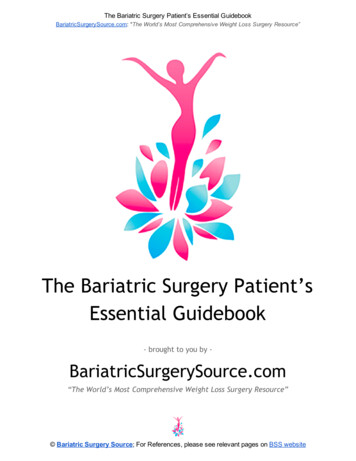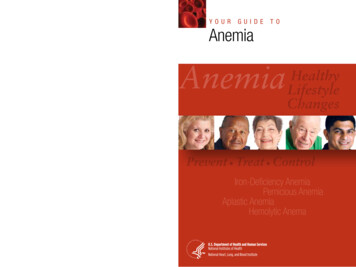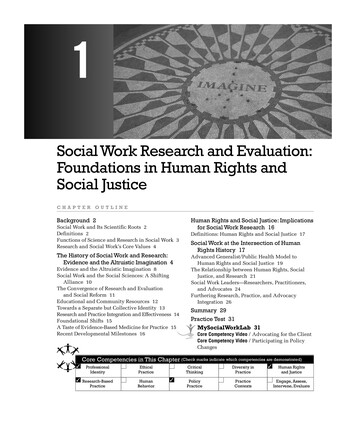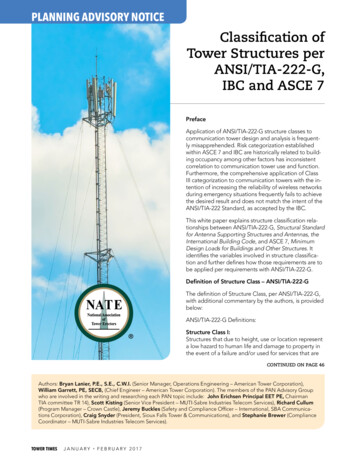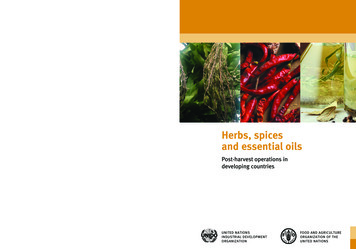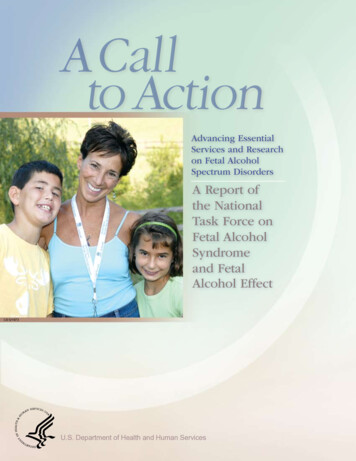
Transcription
Advancing EssentialServices and Researchon Fetal AlcoholSpectrum DisordersA Report ofthe NationalTask Force onFetal AlcoholSyndromeand FetalAlcohol EffectCS121973U.S. Department of Health and Human Services
A Callto ActionAdvancing Essential Services and Researchon Fetal Alcohol Spectrum DisordersA Report of the National Task Force onFetal Alcohol Syndrome and Fetal Alcohol EffectPrepared by:National Task Force on Fetal Alcohol Syndrome andFetal Alcohol Effect Post Exposure Writing GroupHeather Carmichael Olson, PhDMelinda M. Ohlemiller, BA, MAMary J. O’Connor, PhD, ABPPCarole W. Brown, EdDColleen A. Morris, MDKarla Damus, RN, PhDMarch 2009
CONTENTSPageACKNOWLEDGEMENTS. iINTRODUCTION. iiA CALL TO ACTION. 1FREQUENTLY ASKED QUESTIONS. 3APPENDICES. . 7Appendix A: Action Steps for Recommendations of the National Task Force on Fetal Alcohol Syndromeand Fetal Alcohol Effect . . 7Appendix B: Accomplishments of the National Task Force on Fetal Alcohol Syndrome and FetalAlcohol Effect . 9Appendix C: Overview of the Strategic Research Plan on Fetal Alcohol Spectrum Disorders from theNational Institute on Alcohol Abuse and Alcoholism .11Appendix D: Activities of the Centers for Disease Control and Prevention Related to Fetal AlcoholSpectrum Disorders .12Appendix E: Overview of the Substance Abuse and Mental Health Services Administration’s FASDCenter for Excellence .14Appendix F: Information about the Interagency Coordinating Committee on Fetal Alcohol Syndrome . 15REFERENCES.17
ACKNOWLEDGEMENTSSpecial thanks go to the following individuals for the development of this report.National Task Force on Fetal Alcohol Syndrome and Fetal Alcohol Effect - Members: Jean A. Wright, MD (Chair),Backus Children’s Hospital, Savannah, GA; Kristen L. Barry, PhD, Department of Veterans Affairs and University ofMichigan, Ann Arbor, Michigan; James E. Berner, MD, Alaska Native Tribal Health Consortium; Carole W. Brown,EdD, Catholic University of America; Raul Caetano, MD, PhD, MPH, University of Texas School of Public Health;Grace Chang, MD, MPH, Brigham and Women’s Hospital, Boston, MA;Mary C. DeJoseph, DO, Philadelphia College of Osteopathic Medicine; Lisa A. Miller, MD, MSPH,Colorado Department of Public Health and Environment; Colleen A. Morris, MD, University of Nevada School ofMedicine; Mary J. O’Connor, PhD, University of California at Los Angeles School of Medicine;Melinda M. Ohlemiller, BA, MA, Nurses for Newborns Foundation (formerly of the Saint Louis Arc);Heather Carmichael Olson, PhD, University of Washington, School of Medicine; Kenneth R. Warren, PhD, NationalInstitute on Alcohol Abuse and Alcoholism (NIAAA), National Institutes of Health (NIH)Liaison Representatives: George Brenneman, MD, FAAP, American Academy of Pediatrics; Karla Damus, RN,PhD, March of Dimes; George A. Hacker, JD, Center for Science in the Public Interest; Kathleen T. Mitchell, MHS,LCADC, National Organization on Fetal Alcohol Syndrome; Sharon Davis, PhD, Arc of the United States; Robert J.Sokol, MD, American College of Obstetricians and GynecologistsPost-Exposure Working Group Members (Past and Present): George Brenneman, MD, FAAP, AmericanAcademy of Pediatrics; Carole W. Brown, EdD, Catholic University of America; Faye Calhoun, PhD, FormerDeputy Director, NIAAA and consultant to NIAAA; Deborah E. Cohen, PhD (co-chair), New Jersey Departmentof Human Services, Trenton, NJ; Sharon Davis, PhD, Arc of the United States; Callie Gass, FASD Center forExcellence, Substance Abuse and Mental Health Services Administration (SAMHSA); Colleen A. Morris, MD,University of Nevada School of Medicine; Mary J. O’Connor, PhD (co-chair), University of California at LosAngeles School of Medicine; Melinda M. Ohlemiller, Saint Louis Arc; Heather Carmichael Olson, PhD (co-chair),University of Washington, School of Medicine; Charles M. Schad, EdD, Retired Educator, Spearfish, SouthDakota; Jacquelyn Bertrand, PhD, National Center on Birth Defects and Developmental Disabilities (NCBDDD),Centers for Disease Control and Prevention (CDC); Elizabeth Parra Dang, MPH, NCBDDD, CDCPost-Exposure Writing Group: Heather Carmichael Olson, PhD, University of Washington, School of Medicine;Melinda M. Ohlemiller, BA, MA, Nurses for Newborns Foundation (formerly of the Saint Louis Arc);Mary J. O’Connor, PhD, University of California at Los Angeles School of Medicine;Carole W. Brown, EdD, Catholic University of America; Colleen A. Morris, MD,University of Nevada School of Medicine; Karla Damus, RN, PhD, March of DimesAdditional Reviewers and Consultants: Jacquelyn Bertrand, PhD, NCBDDD, CDC;R. Louise Floyd, DSN, RN, NCBDDD, CDC; Mary Kate Weber, MPH, NCBDDD, CDC;Coleen Boyle, PhD, NCBDDD, CDC; José F. Cordero, MD, MPH, University of Puerto Rico School of PublicHealth (formerly Director of NCBDDD, CDC); Kathleen T. Mitchell, MHS, LCADC,National Organization on Fetal Alcohol Syndrome; Robert J. Sokol, MD,American College of Obstetricians and Gynecologists; Kenneth R. Warren, PhD, NIAAA, NIHAppreciation to: the Winokur and Welch families for sharing their photos(Cover: Donnie, Iyal and Morasha Winokur; Page 3: Debbie and Erin Welch).The findings and conclusions in this report are those of the authors and do not necessarily represent the official position of theCenters for Disease Control and Prevention and the U.S. Department of Health and Human Services.i
INTRODUCTIONIn 2004, the National Task Force on Fetal AlcoholSyndrome and Fetal Alcohol Effect, coordinated by theCenters for Disease Control and Prevention’s NationalCenter on Birth Defects and Developmental Disabilities,established a working group committed to addressing theneeds of individuals living with fetal alcohol spectrumdisorders (FASDs) and their families. The culminationof this working group’s discussions and Task Forcedeliberations is reflected in this Call to Action report.The document highlights ten recommendations toimprove and expand efforts regarding early identification,diagnostic services, and quality research on interventionsfor individuals with FASDs and their families. Additionalbackground information is provided to support theserecommendations and to further educate readers on thetopic of FASDs, progress to date, and what still needs tobe done to support individuals with FASDs. The intentof this report is to guide federal, state and local agencies,researchers and clinicians, family support groups, andother partners on actions needed to advance essentialservices for individuals with FASDs and their families andto promote continued intervention research efforts.ii
A CALL TO ACTIONFetal alcohol spectrum disorders (FASDs)are serious, lifelong birth defects and developmentaldisabilities caused by prenatal alcohol exposure. Theyare 100% preventable. Still, a surprisingly large numberof children are born with FASDs each year.FASDs are a public health problem we must face. The U.S.Surgeon General has stated clearly that no amount of alcoholconsumption can be considered safe for a pregnant womanand that alcohol can damage a fetus at any stage of pregnancy(Office of the Surgeon General, 2005). Yet, recent U.S. surveysreveal that approximately 12% of pregnant women still drinkalcohol (CDC, 2004; SAMHSA, 2007). This means 1 in 8fetuses are exposed to alcohol and placed at risk for FASDs.Maternal alcohol use is a growing worldwide phenomenon.It affects children and families of all ethnicities in all societies.Important international collaborative research is beginningto describe the alarming scope of this problem. Whilecommunity and professional awareness of FASDshave increased, expanded awareness and informed actionare sorely needed.FASDs cause a range of lasting medical anddevelopmental problems and result in economiclosses of billions of dollars.FASDs can also mean long-standing suffering for families.FASDs are considered both medical conditions anddevelopmental disabilities. They include a wide range ofconditions, from subtle neurodevelopmental impairmentsto the full fetal alcohol syndrome (FAS). Individuals withFASDs can have physical, mental, behavioral, and/or learningdisabilities with possible lifelong implications. Research showsthat individuals with FASDs often have significant, longterm deficits in functional life skills. These deficits lead toproblems with day-to-day functioning as well as health careissues, including birth defects and increased risk for injury,unintended pregnancy, and sexually transmitted diseases.FASDs can also be associated with mental health difficulties,disrupted school and job experiences, trouble with the law,difficulties with independent living, substance abuse, problemswith parenting, and more (Bertrand et al., 2004; Streissguthet al., 2004). The median adjusted annual cost of fetal alcoholsyndrome has been estimated at 3.6 billion, but the costsassociated with the entire fetal alcohol spectrum are surelymuch higher.Early, appropriate diagnosis of FASDs is a vital firststep to improving outcomes for affected individualsand their families.There is an emerging consensus on how to define FASDs;however, much research is needed to reach a diagnosticstandard and to delineate the entire fetal alcohol spectrum.Diagnostic capacity is growing yet still insufficient in theUnited States, Canada, and abroad. For this reason, manyindividuals with FASDs are unrecognized or misdiagnosed.Efforts are ongoing to create and use standardized, reliablediagnostic systems across the globe and to continuallyimprove guidelines as new knowledge emerges from research.Expert opinion from treating professionals, a wealthof family experience, compelling animal research,and pioneering intervention studies indicatethat appropriate treatment of FASDs can have ameasurable, positive impact.At the present time, even when appropriately diagnosed,individuals with FASDs often receive treatment thatis incomplete or inappropriate. Without suitabletreatment and interventions, individuals with FASDsmay never reach their full potential. Not providingsuitable treatment can also result in unnecessary costs asindividuals enter systems (such as juvenile justice) withproblems that data suggest could have been averted byearlier intervention. Families of affected individuals alsoneed support within the medical and health care systems,and in early intervention and education, juvenile justiceand corrections, substance abuse treatment, mental healthsystems, and social services.1
Fortunately, it is possible to define and address the treatmentproblems raised by FASDs. Because of increasing societalconcern, especially over the past 10 years, important stepshave been taken and the need for further action made veryclear. In the United States, needs assessments have takenplace through nationwide public town hall meetings andcommunity agency initiatives (Ryan, Bonnett & Gass,2006). Intervention guidelines for FASDs are evolving in theUnited States, Canada, England, and other countries aroundthe world. Strategic research plans are in place to stimulatebetter description of the entire fetal alcohol spectrum, honediagnosis, and explain mechanisms of alcohol’s action onthe developing child’s body and brain so that biomarkersand targeted treatments can be identified. An important butlimited program of systematic FASD intervention research hasbegun in the United States and abroad.Collaboration between government agencies,professional organizations, researchers, and familiesis needed to adequately address FASDs.In 2000, the United States Congress initiated a nationalforum for discussion of FASDs and interagency coordinationat the federal level. Building on existing research, and advisedby experts and parents, federal leaders have put in placestrategic research plans for funding the study of FASDs. Topromote further organized action, the Substance Abuse andMental Health Services Administration’s (SAMHSA) FASDCenter for Excellence has compiled a comprehensive databaseof available educational materials and products, research onFASDs, field-initiated efforts to educate professionals andthe public, and community-based and/or research-drivenefforts to provide services. Appendices B through F provideinformation on the efforts of the National Task Force onFetal Alcohol Syndrome and Fetal Alcohol Effect, NationalInstitute on Alcohol Abuse and Alcoholism (NIAAA),Centers for Disease Control and Prevention (CDC),SAMHSA through their FASD Center for Excellence, and theInteragency Coordinating Committee on FAS (ICCFAS).The groundwork has been laid to confront theserious public health problem presented by FASDs.It is reasonable, efficient, and humane to establishan integrated system of services for individualsand families affected by these conditions. This isa problem that can be dealt with, but momentummust be sustained. What is needed is well-informedpublic policy on FASDs and a clear, ongoing societalcommitment to advancing research and ensuringessential services for persons with FASDs andtheir caregivers.2RECOMMENDATIONSThe National Task Force on Fetal Alcohol Syndromeand Fetal Alcohol Effect has developed the followingrecommendations to respond to the need for essentialservices for and research on FASDs. Specific actionsteps to carry out these recommendations are foundin Appendix A.1. Modify eligibility and diagnostic classification systemsto include FASDs so as to recognize FASDs asapproved conditions under all federal disability-relatedbenefit programs.2. Improve diagnostic access by setting up screeningsystems for FASDs and increasing professionalmultidisciplinary diagnostic capacity in communities.3. Intensify research initiatives and interagencycoordination to: delineate the full fetal alcohol spectrum, continue study of alcohol mechanismsand biomarkers, carry out longitudinal descriptive studies, establish effective interventions, translate interventions to the community, and improve the quality and utilization ofinterventions in all service systems forthose with FASDs.4. Promote a comprehensive and accessible continuumof care for families raising infants, children, andadolescents with FASDs.5. Promote a comprehensive and accessible continuumof care for youth, adults, and older individualswith FASDs.6. Encourage comprehensive professional education onFASDs, and assessment of knowledge gained, withinmultiple service systems.7. Enhance strong, collaborative, interagencyleadership at state and national levels (that includesparent representation) to inform legislators,policymakers, and the public.8. Recognize grassroots family support and advocacyorganizations focused on FASDs, which are powerfuland efficient agents of change.9. Improve ongoing national surveillance systems toidentify individuals with FASDs to better trackprevalence, provide needed intervention, andassess the impact of prevention programs.10. Maintain a national forum in which parents,advocates, professional organizations, and expertsin the field of FASDs can work to advanceessential services and research for individuals withFASDs and their families.
FREQUENTLY ASKED QUESTIONSWhat are FASDs?FASDs are increasingly understood as a spectrum orcontinuum of effects found across many aspects of physicaldevelopment, learning, and function (Warren et al., 2004).Individuals with FASDs can, but do not always, showadverse physical signs, such as characteristic facial anomaliesor other body malformations. The learning and functionaleffects of prenatal alcohol exposure are the most troublingand difficult (but important) to identify, diagnose, and treat.These effects vary not only in type, but in severity. Someindividuals can be mildly affected in one area of learning orbehavior, but moderately or severely affected in another area.The range of FASDs includes the full fetal alcohol syndrome(FAS). Although FAS is found in a fairly small proportionof children affected by prenatal alcohol exposure, it is mosteasily diagnosed. Unfortunately, the effects of alcohol arenot readily recognized if they do not fit the classic FASdefinition. A larger number of children, adolescents, andadults have prenatal alcohol–induced impairments that canbe just as serious, or more so, than those seen in people withFAS (Kodituwakku, 2007; Mattson, Riley, Gramling, Delis& Jones, 1998; Riley & McGee, 2005). The terms “partialFAS” and “alcohol-related neurodevelopmental disorder”(ARND) have been applied to these conditions, along withother diagnostic terms. In addition, some children prenatallyexposed to alcohol are born without the characteristic facialfeatures of FAS, but have other alcohol-related physicalabnormalities of the skeleton and certain organ systems.These anomalies are referred to as “alcohol-related birthdefects” (ARBD) (Alcohol Research & Health, 2000;Stratton, Howe & Battaglia, 1996).How does alcohol affect fetal development?Alcohol is a neurobehavioral teratogen—a substance thatthrough prenatal exposure affects the body and (mostimportantly) the brain of a developing fetus. Alcoholalters how neurons and connections between neurons areformed. It also affects development at the cellular, hormonal,neurochemical, structural, and functional levels. It is thoughtthat alcohol exposure affects fetal programming, layingthe groundwork for atypical development and adverse lifeoutcomes. Extensive animal research, long-term humandescriptive studies, clinical studies, and neuroimaging researchall come together to clearly show the lifelong negative impactthat alcohol use during pregnancy can have on the developingchild (Burden, Jacobson & Jacobson, 2005; Gemma, Vichi &Testai, 2007; Hannigan, O’Leary-Moore, & Berman, 2007;Kodituwakku, 2007; Miller & Spear, 2006; Sokol et al.,2007; Spadoni, McKee, Fryer & Riley, 2007; Streissguth etal., 2004; Zhang, Sliwowska & Weinberg, 2005).How common are FASDs?In the United States, FASDs are now known to have a higherprevalence rate than previously thought and to occur across allethnicities. The reported rates of FAS vary widely, dependingon the population studied and surveillance methods used.CDC studies show FAS rates ranging from 0.2 to 1.5 casesper 1,000 live births. Such rates are comparable with or aboveother common developmental disabilities such as DownSyndrome or Spina Bifida (Bertrand et al., 2004). Otheralcohol-related conditions resulting from prenatal exposure,such as partial FAS, ARND, and ARBD, are believed to occurabout three times as often as FAS (Sampson et al., 1997).But the full extent of the problem is still under investigation,and improved prevalence studies are needed. Some haveestimated the rates of the full range of FASDs as high as 9 or10 per 1,000 live births (May & Gossage, 2001; Sampsonet al., 1997). Reasonable estimates translate to about 40,000alcohol-impacted births in the United States each year(Lupton, Burd & Harwood, 2004). FASDs are also a globalhealth problem. FASDs are found worldwide, usually at ratessimilar to those in the United States. But some countrieswith even higher prevalence rates have reached out forguidance and collaboration in research efforts to addressFASDs. Many nations have had long-standing concern aboutFASDs, and there is now emerging alarm in countries thathad not previously recognized the problem. (Viljoen et al.,2005; May et al., 2006).3
Where Are We Now in Responding to FASDs?Prevention of FASDs and community educationremain important.What are the costs of FASDs? The costs of FASDs are bothhuman and financial. The human costs of FASDs arise fromthe debilitating secondary disabilities found among affectedindividuals, and the emotional and financial burdens ontheir families—made clear in nationwide town hall meetingsthat took place from 2002 to 2005 (Ryan, Bonnett & Gass,2006). For instance, parents raising children with clearlydiagnosed FASDs report clinically elevated levels of stress(Paley, O’Connor, Frankel & Marquardt, 2006). Carefulestimates of economic cost data in the United States for thefull fetal alcohol syndrome (FAS) reveal that it is one of themost costly birth defects. Lupton and colleagues (2004)estimated that the median adjusted annual cost of FAS tothe U.S. economy is 3.6 billion. They also estimated thatthe adjusted total lifetime cost per individual with FAS (as of2002 and updated based on the medical services price index)was 2.9 million. Annual state cost estimates vary dependingon population and female at-risk drinking rates. More detailson published cost studies can be found on SAMHSA’s FASDCenter for Excellence website (www.fasdcenter.samhsa.gov).Little is known about costs of the wider fetal alcohol spectrumbeyond FAS, but additional affected individuals can onlyfurther raise societal costs and caregiving burden.4Pregnant women are advised to abstain from all alcoholuse, a long-standing federal advisory that is also supportedby major professional societies (e.g., American College ofObstetricians & Gynecologists, 2005). However, studiesconducted by the CDC (2004) and SAMHSA (2007) foundthat 12% of pregnant women reported consuming alcohol,with 2-3% reporting binge drinking (5 or more drinks perdrinking occasion). Of the approximately 4 million livebirths in the United States per year, this translates to almosta half million women consuming alcohol during pregnancywith an estimated 80,000-120,000 women drinking alcoholat levels that place their babies at increased risk for adverseoutcomes. In another study, approximately 3% of pregnantwomen reported drinking at levels that have been consistentlyassociated with adverse effects on the fetus (Jacobson &Jacobson, 1999). Also, more than half of all women ofchildbearing age (18 through 44 years of age) reportedalcohol use, and approximately one in eight reported bingedrinking in the past month (CDC, 2004; SAMHSA, 2007).Given that half of U.S. pregnancies are unplanned (Finer& Henshaw, 2006), this rate of drinking among women ofchildbearing age poses a substantial risk for FASDs.In response to this public health concern, a clinical plan ofaction for reducing adverse outcomes from prenatal alcoholexposure has been proposed (Floyd, O’Connor, Bertrand &Sokol, 2006). Some progress has been made in preventingFASDs, although prevention must remain a major aim.Educational approaches on screening for and preventingwomen’s drinking have been developed. Both brief andindicated, longer-term preventive treatment methods havebeen tested. The National Task Force on Fetal AlcoholSyndrome and Fetal Alcohol Affect recently reviewed theevidence to date on effective prevention methods to reducealcohol use and alcohol-exposed pregnancies— and developedrecommendations to inform future research, practice, andpublic policy regarding prevention of FASDs (Barry et al.,
2009). Community awareness of FASDs has increased, butmust expand. A broad range of educational materials havebeen created, and these materials need wider dissemination.Importantly, pivotal federal task forces and professionalsocieties are beginning to take a stand on prevention ofFASDs and producing guidelines for how to respond (e.g.,American Academy of Pediatrics, 2000; American College ofObstetricians & Gynecologists, 2006; NIAAA, 2005; U.S.Preventive Services Task Force, 2004).Prevention of FASDs can be achieved. Evidence is accumulatingthat preventive intervention can reduce prenatal alcohol useand increase family planning efforts (e.g., Chang, McNamara& Orav, 2005; Floyd et al., 2007; Grant, Ernst, Streissguth &Stark, 2005; O’Connor & Whaley, 2007). It is important toassess different preventive approaches (universal, selective, andindicated) targeting different types of populations (Hankin,2002), and to study the success of multi-level, community-wideprevention efforts. Continuing, definitive prevention research,including innovations such as the study of neuroprotectiveagents, is crucial. But prevention of FASDs cannot be the onlyresponse to this set of developmental disabilities.Accurate detection and expanded diagnosis of FASDsare essential. Even with prevention efforts, many childrenare born with FASDs and need diagnosis and appropriateintervention across the lifespan. Their families, schools, servicesystems, and larger communities need support and effective,practical ways to respond. Surveillance programs and researchare underway to understand women’s drinking and rates ofFAS. There are small but lively research programs studyingbiomarkers and alcohol exposure ascertainment. This researchwill allow better screening and detection in pregnancy or earlyinfancy. Researchers are actively studying the reliability ofexisting FASD diagnostic systems, while also collaborating toimprove diagnostic methodology through technology such asimaging and both 2-D and 3-D facial modeling. Research tocase-define disorders along the entire fetal alcohol spectrumis underway, using behavioral and physical methodologies,including brain imaging. Better case definitions will allowmore precise estimates of prevalence across the full range ofFASDs. In particular, there is a crucial need to case-definealcohol-related neurodevelopmental disorder (ARND), whichhas not yet been adequately described, although research isactively being pursued. These promising research programsmust continue in order to expand and build momentum toaccomplish the goals of precision in estimating prevalenceand incidence; in detecting prenatal alcohol exposure andthe possible presence of FASDs as early as possible; andin developing clear diagnoses. Meanwhile, though, usefuldiagnostic guidelines do exist (e.g., Bertrand et al., 2004;Chudley et al., 2005). Practical and increasingly widelyused diagnostic systems that can describe the full range ofalcohol-related disabilities are in use, and successful modelsfor diagnostic clinics do exist. What is urgently needed is asignificant increase in FASD diagnostic capacityand accessibility.Intervention for individuals with FASDs is a highpriority. There is real hope that with appropriate and earlyintervention, children with FASDs can have improvedoutcomes. Basic animal research and human studies arebuilding the case that diagnosis and intervention can changeoutcome. Research on animal models of FAS suggeststhat there is neuronal plasticity and that appropriateenvironmental enrichment and motor training has potentialto improve behavioral and learning outcomes and reducealcohol-induced injury to the brain and central nervoussystem. This is thought to be especially true early in life, buteven to occur during the animal equivalent of adolescence orearly adulthood (e.g., Hannigan et al., 2007). Animal researchsuggests that pharmacological treatments may also havepositive effects (e.g., Vaglenova et al., 2007). Natural historyresearch on clinical human samples highlights “protectivefactors” that are related to reduced odds that negativeoutcomes in functional life skills will occur among individualswith FASDs (Streissguth et al., 2004). These protective factorscan be enhanced through intervention.Infant mental health studies and early intervention researchamong children with a variety of developmental disabilitiessuggest strong potential for positive change if interventionis designed on the basis of current scientific data about childdevelopment and early psychopathology (Olson, Jirikowic,Kartin & Astley, 2007). Treatment in the school yearsor adolescence can likely improve educational outcomesand functional life skills, and prevent or reduce secondarydisabilities and debilitating family strife (Coles, Strickland,Padgett & Bellmoff, 2006; Kalberg & Buckley, 2007).Indeed, recent carefully controlled FASD interventionstudies in the United States show positive effects for schoolage children and families (Coles et al., 2009; Interventionsfor Children with FASDs Research Consortium, in press;Kable et al., 2007; O’Connor et al., 2006; Olson et al.,2005), and pilot studies in the United States and abroadshow promise (e.g., Adnams et al., 2007). Even as late asadulthood, diagnosis and intervention for individuals withFASDs are deemed crucial (especially holistic treatment andmanagement of associated mental disorders), and can likelyreduce suffering and cost to affected individuals and thosewho care for them (Streissguth & O’Malley, 2000). Manypromising intervention ideas exist, and parents and providersare discussing what is needed within the full continuum ofservices (Olson, 2006). Some field-initiated interventionprojects are also underway in the United States (seeSAMHSA’s FASD Center for Excellence5
[www.fasdcenter.samhsa.gov] and CDC websites[www.cdc.gov/ncbddd/fas]), and several internationalcooperative projects for prevention and
standard and to delineate the entire fetal alcohol spectrum. Diagnostic capacity is growing yet still insufficient in the United States, Canada, and abroad. For this reason, many individuals with FASDs are unrecognized or misdiagnosed. Efforts are ongoing to create and use standardized, reliable





